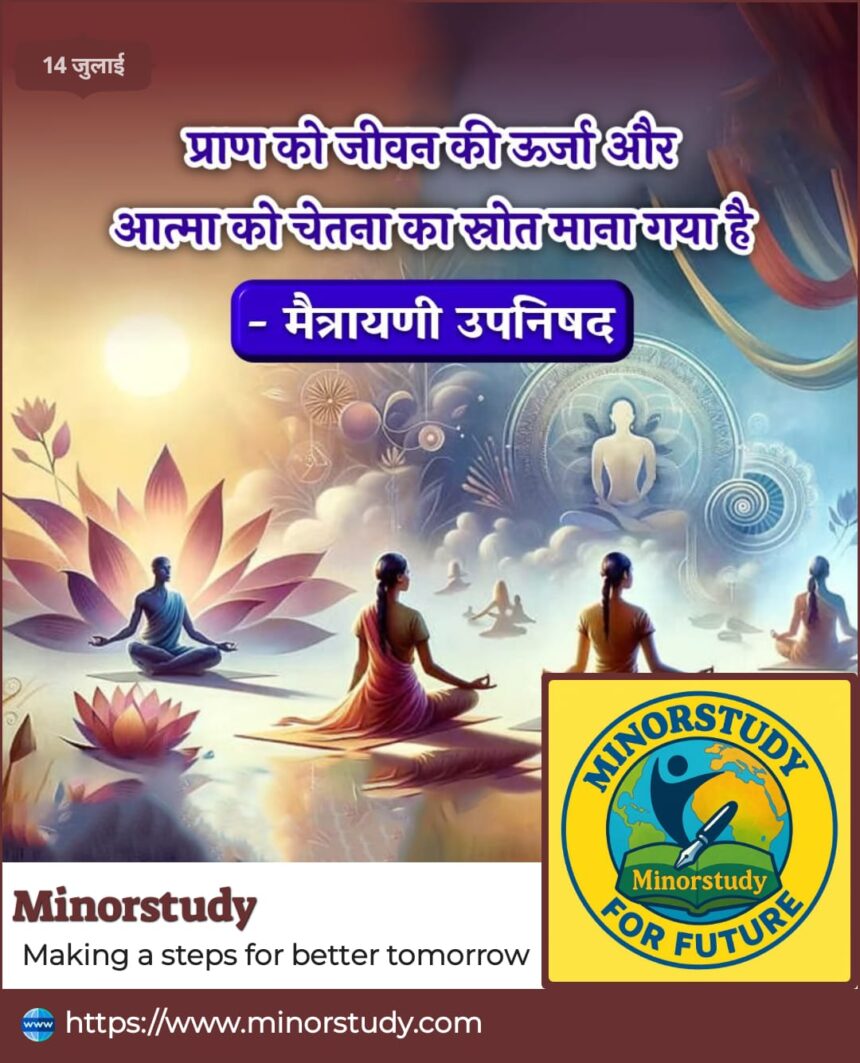🕉️ 5 Eye-Opening Truths from the Maitrayani Upanishad That Illuminate Life and Consciousness
“Prana is the life-energy, and Atman is the source of consciousness.”
— Maitrayani (or Maitri) Upanishad
The Maitrayani Upanishad, also known as the Maitri Upanishad, is one of the ancient Indian spiritual texts that deeply explores the interconnection between Prana (vital life force) and Atman (the Self or Consciousness). These teachings don’t just belong to the spiritual elite—they are profoundly relevant in our daily, modern lives.
- 🕉️ 5 Eye-Opening Truths from the Maitrayani Upanishad That Illuminate Life and Consciousness
- 📜 Introduction to the Maitrayani Upanishad
- 🗓️ Timeline and Historical Background
- 🌿 Core Teaching: Prana and Atman
- ✨ The 5 Eye-Opening Truths from Maitrayani Upanishad
- 1. Prana is the Link Between Body and Consciousness
- 2. Atman is Unchanging, Eternal, and Witnesses All
- 3. Meditation and Renunciation Lead to Realization
- 4. Duality is the Root of Suffering
- 5. The Goal of Life is Union with Brahman
- 📌 Important Points at a Glance
- 💬 Practical Application in Daily Life
- 🙏 Observance: How to Follow Maitrayani Teachings
- 🎉 Wishing in the Light of Maitrayani Wisdom
- ❓ Frequently Asked Questions
- Q1: Is the Maitrayani Upanishad relevant today?
- Q2: How does it differ from other Upanishads?
- Q3: Who should study the Maitrayani Upanishad?
- Q4: What is the connection between Prana and the Mind?
- Q5: Can realization happen without renunciation?
- 🏁 Conclusion: Live with Breath, Live with Self
Let’s explore the history, wisdom, and transformative power of the Maitrayani Upanishad in a human-friendly and engaging way, with practical insights and reflections on how to live with greater awareness, energy, and purpose.
📜 Introduction to the Maitrayani Upanishad
Name Variants: Maitrayani, Maitri, Maitrayaniya
Associated Veda: Krishna Yajurveda
Structure: 7 Chapters (Prapathakas)
Key Themes:
Unity of Self and Ultimate Reality (Brahman)
Meditation (Dhyana)
Prana as Life-Energy
Atman as Pure Consciousness
Renunciation, Self-Knowledge, and Liberation
Unlike some abstract philosophical texts, the Maitrayani Upanishad speaks to the ordinary human struggle with desires, suffering, and fear, offering practical spiritual psychology.
🗓️ Timeline and Historical Background
| Era | Event |
|---|---|
| ~900–700 BCE | Composition of early layers of Maitrayani Upanishad |
| Later Vedic Period | Added philosophical discourses; integration with Krishna Yajurveda |
| ~500 BCE | Prominence in ascetic traditions; studied by Sannyasis and Yogis |
| Classical Era | Commented upon by scholars like Shankaracharya |
| Today | Studied globally by seekers of Self-realization and Yogic science |
🌿 Core Teaching: Prana and Atman
The Maitrayani Upanishad explains that:
Prana is the vital force that sustains life—present in breath, digestion, thought, and even speech.
Atman is the unchanging Self, the source of consciousness and the true identity beyond the body or mind.
Together, they form the bridge between the physical and the eternal, the finite and the infinite.
✨ The 5 Eye-Opening Truths from Maitrayani Upanishad
1. Prana is the Link Between Body and Consciousness
The text teaches:
“All beings are upheld by prana. The universe rests in prana.”
Prana is the fuel of life. Without it, consciousness cannot be expressed through the body.
It governs not just physical functions like heartbeat or digestion, but also emotions and mental clarity.
🧘 Breath is the visible form of Prana. By controlling breath, you control the mind.
2. Atman is Unchanging, Eternal, and Witnesses All
“The Self is immortal, formless, beyond grasp, unborn, unaging.”
While the body ages and the mind changes, Atman remains the same.
Atman is not affected by suffering or joy—it is the silent observer, the awareness in us.
This truth encourages us to detach from ego, emotions, and body-identification, and rest in our true nature.
3. Meditation and Renunciation Lead to Realization
“When the mind becomes still, then the Self is revealed.”
The Maitrayani Upanishad emphasizes inner stillness over rituals.
It advocates for mental renunciation—letting go of craving, fear, and attachment—as the path to liberation.
🔑 Meditation is the bridge to the Atman.
4. Duality is the Root of Suffering
“Where there is duality, there is fear.”
The Upanishad boldly states that the idea of “I” and “the other” is the root of all fear and suffering.
True peace comes when you see no separation—everything is a play of the same consciousness.
This leads to compassion, non-violence, and oneness with all beings.
5. The Goal of Life is Union with Brahman
All practices, austerities, and knowledge are meant to help you realize:
“I am not the body, not the mind, but Brahman.”
Brahman is not different from Atman. Realization of this unity is Moksha (liberation).
🌞 To live in that awareness is to live in perfect freedom, love, and bliss.
📌 Important Points at a Glance
| Concept | Meaning |
|---|---|
| Prana | Life energy present in breath and body functions |
| Atman | The eternal Self, pure awareness |
| Brahman | Supreme reality, infinite consciousness |
| Moksha | Liberation through self-realization |
| Dhyana | Meditation leading to unity of self with Brahman |
| Sannyasa | Renunciation of ego and worldly attachment |
| Oneness | Non-duality: everything is Brahman |
💬 Practical Application in Daily Life
🧘♂️ For the Mind:
Regular breathwork (Pranayama) and meditation calm thoughts and bring clarity.
Witnessing your emotions, rather than reacting, reveals your Atman.
❤️ For Relationships:
Understanding unity dissolves jealousy, comparison, and fear.
You treat others with compassion, seeing the same Self in all.
🌱 For Personal Growth:
Life becomes more about inner evolution than external success.
You experience peace regardless of external ups and downs.
🌎 For Society:
Upanishadic wisdom fosters harmony, service, and ethical living.
Leaders inspired by these values can create a just and spiritual society.
🙏 Observance: How to Follow Maitrayani Teachings
| Practice | Description |
|---|---|
| Meditation | Daily silent sitting and breath awareness |
| Self-Inquiry (Vichara) | Asking “Who am I?” beyond body and mind |
| Non-attachment | Letting go of results, ego, and temporary desires |
| Service (Seva) | Treating others with the same reverence as the Self |
| Scripture Study | Reflecting on Upanishadic verses regularly |
🎉 Wishing in the Light of Maitrayani Wisdom
🌼 May your breath guide you inward.
🌸 May your Self shine through all illusions.
🌞 May you realize your unity with the Infinite.
🌿 May Prana fill you with vitality, and Atman lead you to peace.
❓ Frequently Asked Questions
Q1: Is the Maitrayani Upanishad relevant today?
Absolutely. Its focus on inner awareness, breath, and self-knowledge is deeply relevant in our modern stressful lives.
Q2: How does it differ from other Upanishads?
While all Upanishads aim at liberation, Maitrayani emphasizes prana and renunciation as central paths to realizing the Self.
Q3: Who should study the Maitrayani Upanishad?
Anyone interested in spirituality, yoga, meditation, or philosophy—from seekers to scholars—will benefit from its timeless wisdom.
Q4: What is the connection between Prana and the Mind?
The Upanishad says, “Where prana flows, the mind goes.” A disturbed breath equals a disturbed mind. Control one, and you control the other.
Q5: Can realization happen without renunciation?
True renunciation is not external. The Maitrayani teaches that internal detachment is what truly leads to freedom.
🏁 Conclusion: Live with Breath, Live with Self
The Maitrayani Upanishad reminds us that life is not just about survival or success—it’s about Self-realization. Your breath is sacred. Your Self is eternal. And awakening to that truth is the highest purpose of life.
This Upanishad is not merely to be studied, but to be lived — through mindfulness, inquiry, love, and letting go.
🌬️ Let your breath carry you to stillness.
🕉️ Let your stillness reveal the Self.
🔥 Let the Self dissolve all illusion.








